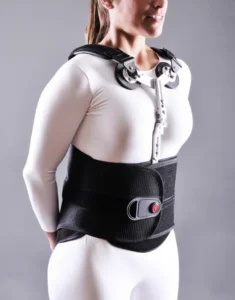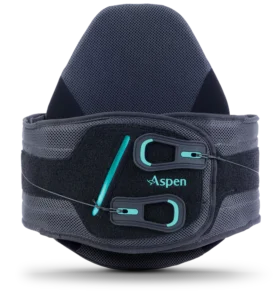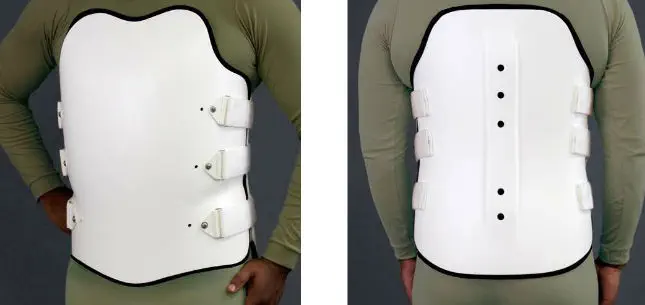
Back bracing is a frequent topic of discussion at Red Butte Pain Solutions. For example, nearly 70% of patients with vertebral compression fractures report significant pain relief when using a brace, highlighting its importance in recovery and pain management. Many patients come to us with questions about back braces—some wearing a clamshell brace prescribed after being discharged from the hospital for a vertebral compression fracture, while others rely on elastic belts they found online. A question we hear often is: “Is back bracing good for me?”
The answer depends on various factors, including the type of brace, the condition being treated, and how the brace is used. In this post, we’ll explore the different types of back braces, their roles in managing back pain and spinal conditions, and the pros and cons of using them.
Types of Back Braces
Back braces vary widely in terms of design, purpose, and effectiveness. Choosing the right brace requires understanding the options and their applications.

TLSO Braces
- What is a TLSO brace?
TLSO stands for thoracolumbosacral orthosis. These are rigid, medical-grade braces that cover the thoracic spine (upper back), lumbar spine (lower back), and sacrum. - How does it work?
A TLSO brace immobilizes the spine, reducing movement that could aggravate pain or delay healing. It’s often custom-fitted to ensure proper support and comfort. - When is it used?
TLSO braces are commonly prescribed for spinal fractures, scoliosis, or post-surgery recovery. For example, a patient recovering from a vertebral compression fracture in the mid-back might wear a TLSO brace for several weeks.

LSO Braces
- What is an LSO brace?
LSO stands for lumbosacral orthosis. These braces support the lower back and sacrum. - How does it work?
Similar to the TLSO, the LSO brace stabilizes the lumbar spine and reduces motion, promoting healing and pain relief. - When is it used?
Patients with lumbar spine fractures, severe arthritis, or degenerative disc disease may benefit from an LSO brace. It is also used in cases of chronic lower back pain when other treatments haven’t provided relief.

Clamshell Braces
- What is a clamshell brace?
This rigid brace gets its name from its shell-like design. It encases the torso completely, offering maximal immobilization. - How does it work?
The clamshell brace prevents all spinal movement, making it ideal for conditions requiring strict stabilization. - When is it used?
Clamshell braces are often prescribed after hospital discharge for severe spinal injuries or fractures. They’re particularly useful in the early stages of healing.
Elastic Support Belts/Braces
- What are elastic belts?
These are over-the-counter braces made from flexible materials like neoprene or elastic fabric. - How does it work?
Elastic belts provide mild compression and support, which can reduce strain on the lower back muscles. - When is it used?
They’re best for temporary use, such as during heavy lifting or managing mild back strain. While not as effective as medical-grade braces, they offer comfort and convenience for less severe conditions.
True Orthotic Braces vs. Elastic Support Belts
Understanding the differences between orthotic braces and elastic belts is crucial when choosing the right option for your condition. For instance, a patient recovering from a lumbar compression fracture may require an LSO brace to stabilize their spine and reduce pain, while someone with mild back strain might find an elastic support belt sufficient for temporary relief.
Orthotic Braces
- Design: Rigid and typically custom-fitted by a healthcare provider.
- Purpose: Provide significant spinal stabilization to aid healing.
- Effectiveness: Backed by clinical evidence for conditions like fractures, post-surgical recovery, or scoliosis.
- Drawbacks: Can be bulky, expensive, and may require regular adjustments.
Elastic Support Belts
- Design: Flexible and widely available without a prescription.
- Purpose: Offer mild support and compression, reducing discomfort from muscle strain or minor injuries.
- Effectiveness: Limited to short-term symptom relief. They are not suitable for managing serious spinal conditions.
- Drawbacks: Provide minimal structural support and may give a false sense of security during activities that strain the spine.
Benefits of Back Bracing
Back braces can be invaluable tools when used appropriately. Here’s how they help: For instance, a patient recovering from a lumbar compression fracture might use an LSO brace to stabilize the spine, reduce pain, and improve mobility. Meanwhile, an individual with mild lower back strain could find relief with an elastic belt, which provides temporary support during daily activities.
- Pain Relief:
By reducing spinal motion, braces alleviate stress on painful areas, particularly in cases of fractures or arthritis. - Improved Stability:
Braces stabilize the spine, preventing further injury during recovery from fractures or surgeries. - Enhanced Functionality:
With reduced pain, patients often find it easier to perform daily tasks. For example, someone with severe lower back pain might use an LSO brace to remain mobile at work or home. - Support During Healing:
For patients recovering from injuries, braces provide the necessary support to aid tissue repair and reduce the risk of reinjury.
Drawbacks of Back Bracing
While bracing offers significant benefits, proper guidance is essential to avoid complications from prolonged or improper use:
- Deconditioning of Back Muscles:
Long-term bracing can weaken the muscles that support the spine, leading to increased pain and reduced mobility once the brace is removed. - Dependency:
Over-reliance on a brace can discourage patients from engaging in physical therapy, delaying recovery. - Limited Long-Term Effectiveness:
Braces address symptoms but do not treat underlying issues, such as degenerative disc disease or muscle imbalances.
Avoiding Deconditioning
To counteract muscle deconditioning, braces should be used in conjunction with a supervised physical therapy program. Exercises targeting core strength and flexibility can help maintain muscle function during bracing.
Back Bracing for Vertebral Compression Fractures
Vertebral compression fractures are a common reason for back bracing. Here’s how braces play a role:
Before Kyphoplasty or Vertebroplasty
- Braces stabilize the spine and reduce pain, allowing patients to remain active while awaiting procedures like kyphoplasty and vertebroplasty.
- Example: A patient with a T12 compression fracture might wear a TLSO brace for 4–6 weeks before undergoing kyphoplasty.
For Non-Surgical Candidates
- Not all patients are candidates for kyphoplasty or vertebroplasty. In such cases, braces provide a non-invasive way to manage pain and promote healing.
- Braces can help these patients maintain mobility and avoid complications like worsening fractures or chronic pain.
How to Choose the Right Back Brace
Selecting the right brace involves collaboration between a physician and an orthotics specialist. A physician evaluates the underlying condition and determines whether a brace is appropriate, while an orthotics specialist ensures proper fit and customization for maximum effectiveness. This teamwork is essential to achieve optimal outcomes and prevent complications.
Choosing an appropriate brace ensures effective support and avoids complications during recovery.
- Condition:
For fractures, rigid orthotic braces are essential. For minor back strain, elastic belts may suffice. - Fit:
Custom-fitted braces ensure proper support and comfort, reducing the risk of complications. - Duration:
Use braces as directed by your healthcare provider. Avoid prolonged use without physical therapy.
Practical Tips for Using a Back Brace
To maximize the benefits of a back brace:
- Follow Your Doctor’s Instructions:
Use the brace for the prescribed duration and activities. - Combine with Physical Therapy:
Strengthen your back muscles with targeted exercises to prevent deconditioning. - Wear Correctly:
Ensure the brace fits snugly without causing discomfort or restricting breathing.
Expert Guidance for Back Bracing
If you’re considering a back brace or need expert care for back pain or vertebral compression fractures, Red Butte Pain Solutions is here to help. Call us at 602-633-4334 or schedule an appointment to explore your options and regain control of your life.
